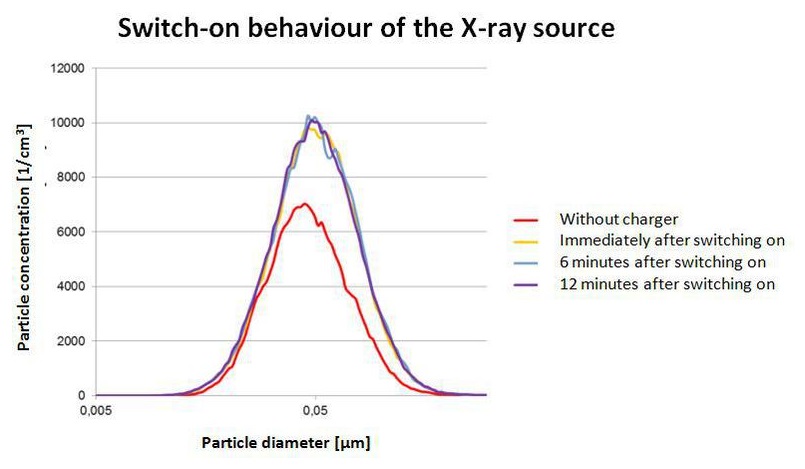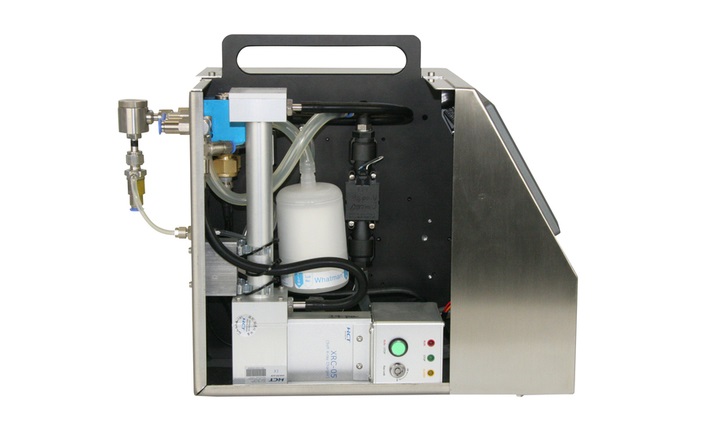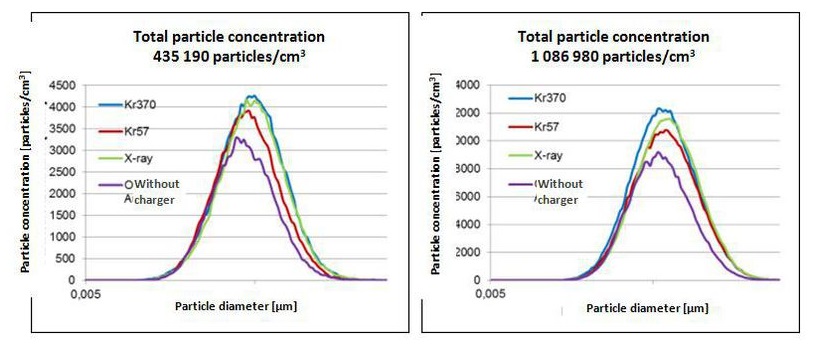Model Description
The XRC 370 is a neutralizer on the basis of X-ray ionization. It can be used the same way as the Kr-85-370 (for example in SMPS systems), i.e. when the measurement task requires a reliable and defined charge distribution of the aerosol.
The XRC 370 is especially suitable for measurements performed at different locations, as there are no official requirements for the transport that need to be considered.
The XRC 370 is a bipolar neutralizer generating positive and negative ions through ionization. If these ions are brought together with an aerosol, a defined equilibrium charge distribution is set, as it is necessary for measuring systems such as a scanning mobility particle sizer (e.g. Palas® U-SMPS*).
Compared to an unipolar neutralization, a bipolar neutralization has a significant advantage: regardless of the initial state of charge of the particles, a reproducible equilibrium charge distribution is always set. This is why a bipolar neutralization is mandatory for a traceable calibration of a condensation particle counter (e.g. ISO/CD 27891).
The XRC 370 can be integrated into the U-SMPS / DEMC control unit (figure 3). The full performance is immediately available after switching on the device, after switching off no ionization takes place and therefore no further radiation.
Quality in Detail
Function
The highly-energized X-rays ionize the carrier gas. As a first result of the ionization process, positively charged gas ions and free electrons are generated. Neutral gas molecules with a strong electron affinity (e.g. O2) collect the free electrons to build negatively charged ions.
When, at this point, aerosol particles are exposed to this mixture of ions during a determined period of time, the charge level of the aerosol particles is set at a defined equilibrium charge distribution. Figure 1 shows a schematic set-up of the X-ray source. In the light blue area ions (in dark blue) are generated. The aerosol particles (grey) pass through the light blue area and collide with the ions.

Figure 1: Schematic set-up of XRC 370
Performance
The XRC 370 was characterized and tested during the research of a bachelor thesis. It was analysed if it is suitable as an alternative to a Kr-85 neutralizer.
It was found that the following parameters have either no effect or only little effect on the neutralization of the aerosol particles:
- Switch-on behaviour
- Volume flow
- Particle material
- Concentration
An important advantage of the XRC 370 is that it can be switched off. This extends the life significantly, as only in operation the electrodes are charged, so that the source can often be used over several years. If it is switched off, no ionization takes place and no radioation exposes. Therefore it can be transported without restrictions. The XRC 370 does not need any warm-up period. Directly after switching on the aerosol is completely neutralized (figure 2).

Figure 2: Distribution measurement for the determination of the switch-on behaviour of the XRC 370 X-ray source
Furthermore it has been tested if the neutralization decreases at a defined volume flow. For this, measurements have been performed at different volume flows. For the tested aerosol volume flows up to 6 l/min no influences on the neutralization of the aerosol particles have been determined.

Figure 3: XRC 370 integrated into U-SMPS / DEMC control unit
As the particle form and particle material can influence the ionization, different materials have been tested (e.g. graphite in figure 4). As a result the agreement between Kr-85-370 and XRC 370 was generally very good.

Figure 4: Measured size distribution for graphite particles
Indeed the charge distribution of the XRC 370 is neutral, whereas the charge distribution of the Kr-85-370 is shifted into negative direction. This can be seen especially at higher concentrations and shows e.g. at a concentration of 106 particles/cm3 (figure 5) a difference of 7 %. This is the reason why it can be chosen with the U-SMPS/DEMC control unit (figure 3) which kind of neutralizer is being used.

Figure 5: Comparison of concentration of neutralizers
Handling
The regulations regarding X-rays are slightly different in every country. Please contact the competent authority in order to obtain more detailed information on the operation of the XRC 370. Should you have any questions related to this, we will be pleased to help you.
*Further information regarding the Palas® U-SMPS system are available in the corresponding product brochure.
Particular Advantages
- Reliable method for setting defined bipolar charge distributions
- Powerful alternative to radioactive neutralizers
- Flexibility in operation, no additional operating licence required**
- Can be integrated into U-SMPS / DEMC control unit
- After switching on full performance available, after switching off no further ionization
- Suitable for concentrations up to 107 particles/cm3
- Reduces your operating costs!
** Regulations and requirements can vary depending on the state/country